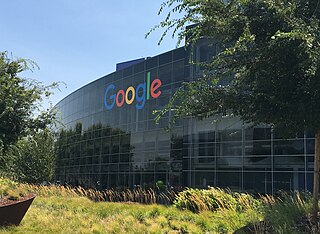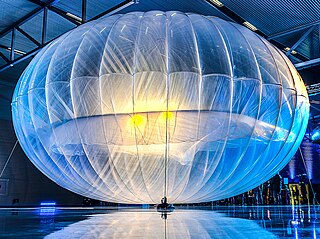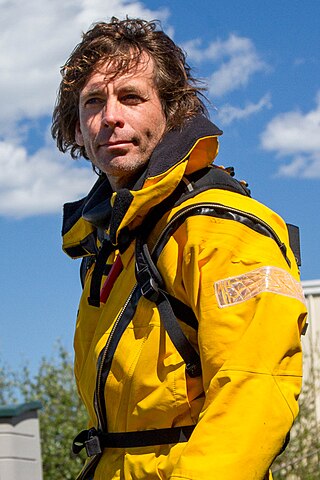
Lawrence Edward Page is an American billionaire business magnate, computer scientist and internet entrepreneur best known for co-founding Google with Sergey Brin.

Google LLC is an American multinational technology company focusing on artificial intelligence, online advertising, search engine technology, cloud computing, computer software, quantum computing, e-commerce, and consumer electronics. It has been referred to as "the most powerful company in the world" and as one of the world's most valuable brands due to its market dominance, data collection, and technological advantages in the field of artificial intelligence. Alongside Amazon, Apple Inc., Meta Platforms, and Microsoft, Google's parent company Alphabet Inc. is one of the five Big Tech companies.

An airborne wind turbine is a design concept for a wind turbine with a rotor supported in the air without a tower, thus benefiting from the higher velocity and persistence of wind at high altitudes, while avoiding the expense of tower construction, or the need for slip rings or yaw mechanism. An electrical generator may be on the ground or airborne. Challenges include safely suspending and maintaining turbines hundreds of meters off the ground in high winds and storms, transferring the harvested and/or generated power back to earth, and interference with aviation.
Boston Dynamics is an American engineering and robotics design company founded in 1992 as a spin-off from the Massachusetts Institute of Technology. Headquartered in Waltham, Massachusetts, Boston Dynamics has been owned by the Hyundai Motor Group since December 2020, but having only completed the acquisition in June 2021.

Saul Griffith is an Australian-American inventor and renewable electricity advocate. He is the founder or co-founder of multiple companies, including Otherlab, Makani Power, and Instructables.

Eric "Astro" Teller is an American entrepreneur, computer scientist, and author, with expertise in the field of intelligent technology.

Andrew Yan-Tak Ng is a British-American computer scientist and technology entrepreneur focusing on machine learning and artificial intelligence (AI). Ng was a cofounder and head of Google Brain and was the former Chief Scientist at Baidu, building the company's Artificial Intelligence Group into a team of several thousand people.
Squid Labs was an American independent research and development company founded by a group of four MIT graduates. In 2004, Colin Bulthaup, Dan Goldwater, Saul Griffith, and Eric Wilhelm moved from the East Coast to California to found the company known as Squid Labs. During its years of existence from 2004 to 2007, Squid Labs added three more members to its team: Geo Homsy, Corwin Hardham and Ryan McKinley. Working out of a warehouse in Emeryville, the group adopted the slogan "We're not a think tank, we're a do tank." and created a handful of patents and inventions including an electronically sensed rope, portable pull-cord generators, and a machine that could manufacture eyeglasses of any prescriptions at extremely low cost. Squid Labs was also the birthplace for many companies still running today, such as Makani Power and Howtoons. Although the company no longer exists, Squid Lab's co-founder, Saul Griffith created a similar company in San Francisco named Otherlab.
Makani Technologies LLC was an Alameda, California-based company that developed airborne wind turbines. Founded in 2006, Makani was acquired by Google in May 2013. In February 2020, Makani was shut down by Alphabet, Google's parent company.
Solve for X was a community solution engagement project and think tank-like event launched by Google to encourage collaboration, solve global issues and support innovators. The "X" in the title represents a remedy that someone or a team is already pursuing which ran from 2012 to 2014.

Loon LLC was an Alphabet Inc. subsidiary working on providing Internet access to rural and remote areas. The company used high-altitude balloons in the stratosphere at an altitude of 18 km (11 mi) to 25 km (16 mi) to create an aerial wireless network with up to 1 Mbit/s speeds. A reference to the balloons used, Project Loon began as a research and development project by X in 2011, but later spun out into a separate company in July 2018. In January 2021, it was announced that the company would be shut down due to lack of profitability.
Google Brain was a deep learning artificial intelligence research team under the umbrella of Google AI, a research division at Google dedicated to artificial intelligence. Formed in 2011, Google Brain combined open-ended machine learning research with information systems and large-scale computing resources. The team has created tools such as TensorFlow, which allow for neural networks to be used by the public, with multiple internal AI research projects. The team aims to create research opportunities in machine learning and natural language processing. The team was merged into former Google sister company DeepMind to form Google DeepMind in April 2023.
Internet.org is a partnership between social networking services company Meta Platforms and six companies that plans to bring affordable access to selected Internet services to less developed countries by increasing efficiency, and facilitating the development of new business models around the provision of Internet access. The app delivering these services was renamed Free Basics in September 2015. As of April 2018, 100 million people were using internet.org.

Verily Life Sciences LLC, also known as Verily, is Alphabet Inc.'s research organization devoted to the study of life sciences. The organization was formerly a division of Google X, until August 10, 2015, when Sergey Brin announced that the organization would become an independent subsidiary of Alphabet Inc. with restructuring completed on October 2, 2015. On December 7, 2015, Google Life Sciences was renamed Verily.

Alphabet Inc. is an American multinational technology conglomerate holding company headquartered in Mountain View, California. It was created through a restructuring of Google on October 2, 2015, and became the parent company of Google and several former Google subsidiaries. Alphabet is the world's third-largest technology company by revenue and one of the world's most valuable companies. It is considered one of the Big Five American information technology companies, alongside Amazon, Apple, Meta, and Microsoft.

Donald Lewis Montague is a Canadian-American watersport athlete and designer. He is President of Kai Concepts, co-founder of Makani Power, and the head of the Kiteboat Project in Alameda, California.
Sidewalk Labs LLC is an urban planning and infrastructure subsidiary of Google. Its stated goal is to improve urban infrastructure through technological solutions, and tackle issues such as cost of living, efficient transportation and energy usage. The company was headed by Daniel L. Doctoroff, former Deputy Mayor of New York City for economic development and former chief executive of Bloomberg L.P. until 2021. Other notable employees include Craig Nevill-Manning, co-founder of Google's New York office and inventor of Froogle, and Rohit Aggarwala, who served as chief policy officer of the company and is now Commissioner of New York City Department of Environmental Protection. It was originally part of Alphabet Inc., Google's parent company, before being absorbed into Google in 2021 following Doctoroff's departure from the company due to a suspected ALS diagnosis.

Dandelion is an American geothermal heating supplier in the Northeast United States. Prior to 2017, the company was part of Google X, before turning into an independent company. Dandelion targets providing geothermal heating and cooling (HVAC).

Hans Peter Brøndmo is an American-Norwegian computer scientist and technology entrepreneur. In 2016 he became vice president at X and general manager of the Everyday Robots project. He previously worked at Apple Computer on Hypercard development, founded startups in online marketing and social media and held executive positions at Nokia Corporation and Google.














